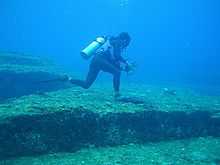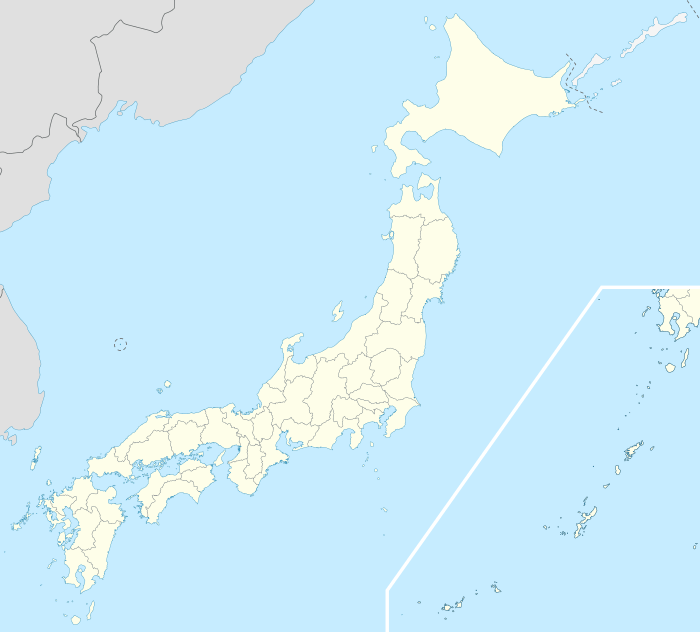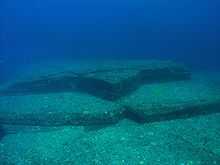Yonaguni Monument


The Yonaguni Monument (与那国島海底地形 Yonaguni-jima Kaitei Chikei, lit. "Yonaguni Island Submarine Topography") is an underwater structure off the coast of Yonaguni, the southernmost of the Ryukyu Islands, in Japan. There is a debate about whether the site is completely natural, is a natural site that has been modified, or is a man-made artifact.[1][2] For these reasons, the site is also known in Japanese as the "Yonaguni (Island) Submarine Ruins" (与那国(島)海底遺跡 Yonaguni(-jima) Kaitei Iseki).
Discovery
The sea off Yonaguni is a popular diving location during the winter months owing to its large population of hammerhead sharks. In 1987, while looking for a good place to observe the sharks, Kihachiro Aratake, a director of the Yonaguni-Cho Tourism Association, noticed some singular seabed formations resembling architectonic structures.[3] Shortly thereafter, a group of scientists directed by Masaaki Kimura of the University of the Ryūkyūs visited the formations.
The formation has since become a relatively popular attraction for divers despite the strong currents.[3] In 1997, Japanese industrialist Yasuo Watanabe sponsored an informal expedition comprising writers John Anthony West and Graham Hancock, photographer Santha Faiia, geologist Robert Schoch, a few sport divers and instructors, and a shooting crew for Channel 4 and Discovery Channel. Another notable visitor was freediver Jacques Mayol, who wrote a book on his dives at Yonaguni.[4]
Main features
The Monument consists of medium to very fine sandstones and mudstones of the Lower Miocene Yaeyama Group believed to have been deposited about 20 million years ago.[1] Most of the formations are connected to the underlying rock mass (as opposed to being assembled out of freestanding rocks).

The main feature (the "Monument" proper) is a rectangular formation measuring about 150 by 40 m (490 by 130 ft) and about 27 m (90 ft) tall; the top is about 5 m (16 ft) below sea level.[5]
Some of its details are said to be:
- Two closely spaced pillars which rise to within eight feet of the surface;
- A 5 m (16 ft) wide ledge that encircles the base of the formation on three sides
- A stone column about 7 m (23 ft) tall
- A straight wall 10 m (33 ft) long
- An isolated boulder resting on a low platform;
- A low star-shaped platform;
- A triangular depression with two large holes at its edge;
- An L-shaped rock.
Interpretations
Artificial structures
The flat parallel faces, sharp edges, and mostly right angles of the formation have led many people, including many of the underwater photographers and divers who have visited the site and some scholars, to the opinion that those features are man-made.[6] These people include Gary and Cecilia Hagland[6] and Tom Holden, who went on underwater expeditions to study and photograph the site. These features include a trench that has two internal 90° angles as well as the twin megaliths that appear to have been placed there. These megaliths have straight edges and square corners. However, sea currents have been known to move large rocks on a regular basis.[2][5][7][8] Some of those who see the formations as being largely natural claim that they may have been modified by human hands.[1] The semiregular terraces of the Monument have been compared to other examples of megalithic architecture, such as the rock-hewn terraces seen at Sacsayhuaman.[9] The formations have also been compared to the Okinawa Tomb, a rock-hewn structure of uncertain age
Other evidence presented by those who favor an artificial origin include the two round holes (about 2 feet wide, according to photographs) on the edge of the Triangle Pool feature and a straight row of smaller holes that have been interpreted as an abandoned attempt to split off a section of the rock by means of wedges, as in ancient quarries. Kimura believes that he has identified traces of drawings of animals and people engraved on the rocks, including a horselike sign that he believes resembles a character from the Kaida script. Some have also interpreted a formation on the side of one of the monuments as a crude moai-like "face".
Supporters of artificial origin, such as Graham Hancock,[6] also argue that, while many of the features seen at Yonaguni are also seen in natural sandstone formations throughout the world, the concentration of so many peculiar formations in such a small area is highly unlikely.[6] They also point to the relative absence of loose blocks on the flat areas of the formation, which would be expected if they were formed solely by natural erosion and fracturing. Robert Schoch has noted that the rocks are swept with strong currents.[10]
Kimura first estimated that the monument must be at least 10,000 years old (8,000 BCE), dating it to a time when it would have been above water.[7] In a report given to the 21st Pacific Science Congress in 2007, he revised this estimate and dated it to 2,000 to 3,000 years ago because the sea level then was close to current levels. He suggests that after construction tectonic activity caused it to be submerged below sea level. Archaeologist Richard J. Pearson believes this to be unlikely.[10] Kimura believes he can identify a pyramid, castles, roads, monuments and a stadium, and has surmised that the site may be a remnant of the mythical lost continent of Mu.[2]
The existence of an ancient stoneworking tradition at Yonaguni and other Ryukyu islands is demonstrated by some old tombs and several stone vessels of uncertain age.[1] Small camps, pottery, stone tools and large fireplaces were found on Yonaguni possibly dating back to 2500 BCE; Pearson notes that these were small communities, adding "They are not likely to have had extra energy for building stone monuments."[10]
Natural formation
Some of those who have studied the formation, such as geologist Robert Schoch of Boston University, state that it is most likely a natural formation, possibly used and modified by humans in the past. Schoch observes that the sandstones that make up the Yonaguni formation "contain numerous well-defined, parallel bedding planes along which the layers easily separate. The rocks of this group are also criss-crossed by numerous sets of parallel and vertical (relative to the horizontal bedding planes of the rocks) joints and fractures. Yonaguni lies in an earthquake-prone region; such earthquakes tend to fracture the rocks in a regular manner."[1][11] He also observes that on the northeast coast of Yonaguni there are regular formations similar to those seen at the monument.[1][12] Schoch also believes that the "drawings" identified by Kimura are natural scratches on the rocks.[11] This is also the view of John Anthony West.[3] He also suggests that walls are simply natural horizontal 'platforms' which fell into a vertical position when rock below them eroded and the alleged roads are simply channels in the rock.[10]
Patrick D. Nunn, Professor of Oceanic Geoscience at the University of the South Pacific, has studied these structures extensively and notes that the structures below the water continue in the Sanninudai slate cliffs above, which have "been fashioned solely by natural processes," and concludes in regard to the underwater structures that "there seems no reason to suppose that they are artificial."[13]
Other examples of natural formations with flat faces and sharp, straight edges are the basalt columns of the Giant's Causeway and the natural staircase formation on Old Rag Mountain.[14]
Media references
The monument was featured on episodes of Ancient Aliens and History's Mysteries, both on The History Channel.
See also
| Wikimedia Commons has media related to Yonaguni Monument. |
- Bimini Road
- Giant's Causeway
- Marine archaeology in the Gulf of Cambay
- UNESCO Convention on the Protection of the Underwater Cultural Heritage
References
- ↑ 1.0 1.1 1.2 1.3 1.4 1.5 Schoch, Robert M. (1999). "Yonaguni Enigmatic Underwater Monuments". Retrieved 2010-07-06.
- ↑ 2.0 2.1 2.2 Kimura, Masaaki (1991). Mu tairiku wa Ryukyu ni atta (The Continent of Mu was in Ryukyu) (in Japanese). Tokyo: Tokuma Shoten.
- ↑ 3.0 3.1 3.2 West, John Anthony (1998). "Diving for Lemuria". Retrieved 2010-07-06.
- ↑ Mayol, Jacques. Heritage des Peuples de la Mer.
- ↑ 5.0 5.1 Ancient Discoveries: Lost Cities of the Deep History Channel
- ↑ 6.0 6.1 6.2 6.3 "Japan's Mysterious Pyramids". World History. Episode SKU ID #70565. 2000-12-11. 50 minutes minutes in. History Channel.
- ↑ 7.0 7.1 History's Mysteries: Japan's mysterious pyramids History channel , ep. #7
- ↑ "Umi ni shizunda chō-kodai bunmei (The Submerged Ancient Civilizations)". Quark (Kōdansha). 2002.
- ↑ "Finely chiseled rock steps at the ruins of Sacsayhuaman outside of Cuzco". Retrieved 2010-07-06.
- ↑ 10.0 10.1 10.2 10.3 "Yonaguni, Japan". New Scientist (2736). 2009-11-25. Archived from the original on 2009-11-28. Retrieved 2012-10-14.
- ↑ 11.0 11.1 Ryall, Julian (2007-09-19). "Japan's Ancient Underwater "Pyramid" Mystifies Scholars". Retrieved 2010-07-06.
- ↑ "National Geographic News Photo Gallery: Asian "Atlantis" Shows Strange Structure". Retrieved 2010-07-06.
- ↑ Nunn, Patrick D. (2009). Vanished Islands and Hidden Continents of the Pacific. Honolulu: University of Hawaii Press. p. 127. ISBN 978-0-8248-3219-3.
- ↑ "Hiker's Guide to the Geology of Old Rag Mountain" (PDF).